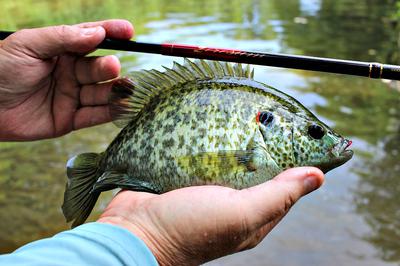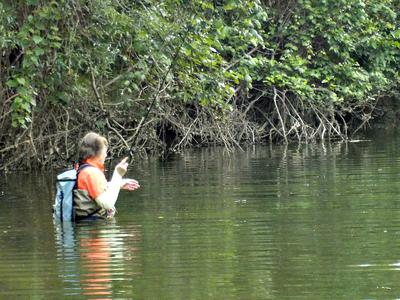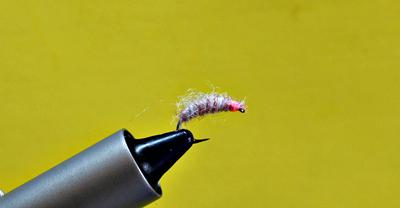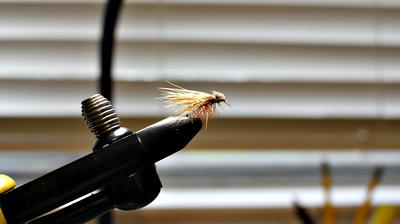Pattern, Presentation, or Both?
by John Evans
(San Antonio, TX)

This beautiful Redear Sunfish couldn't resist a Killer Bug bounced along the bottom.
Anglers love a good debate, and tenkara practitioners are no different. One argument I hear from time-to-time is whether fly pattern or presentation is more important. We all have our favorite flies that we cast with confidence, but even the best fly must be presented in the right way. So, which is more important—pattern or presentation?
Experience shows that both matter. There’s no doubt that certain patterns work better on some days. Time of year also influences which fly works best. Some patterns have a history of producing good results under a variety of conditions. The Utah Killer Bug, Elk Hair Caddis, and Hare’s Ear Nymph come to mind.
Yes, I know there are one-fly only advocates, but I’m just not convinced by that theory. When the fish are feeding off the bottom in deeper water, an unweighted sakasa kebari is not going to cut it. Sometimes the only fly the fish will strike is a nymph bouncing along the bottom. Sometimes streamers are effective, and at other times a favorite dry or wet fly does the trick.
But presentation is key . . . often more important than the fly itself. In fact, tenkara angling emphasizes presentation. You can’t just plow into a creek, slap a fly on the water any which way, and expect to be effective. Yes, even an old blind hog finds an acorn now and again, but the angler who stealthily approaches his quarry, who presents the fly in a natural way in fish-holding water, who works the fly as an insect might appear on the water, is going to catch more fish. I repeat: it’s presentation and pattern.
Experience, the most thorough of all teachers, shows us this.
Frank Sawyer, who knew a thing or two about fishing, and who gave us some of our most effective patterns (pheasant tail nymph, Sawyer’s killer bug), repeatedly emphasized the importance of stealth and presentation. In his books, he describes how to cast the fly so that it enters the water properly and how to gently work the artificial. Today we may focus on Sawyer’s patterns, but a review of his writing shows that approach and presentation were keys in his thinking.
I would also say that one common mistake most of us make is to overwork a fly. Hey, if a little twitching is good, a lot of twitching must be better. Again, experience shows that’s not true. Most insects, if they fall into the water, struggle just a little and then sit still. We would be wise to imitate what happens in nature. Fish quickly identify any object that’s moving too much or making too much of a commotion. (Yes, I know there are exceptions to this rule, but the principle remains.) Often, a dead drift is most effective of all.
My encouragement is to consider both pattern and presentation. Find the flies that work in your area, in the way you fish, and tie those patterns with confidence. But remember that most fish are easily spooked and soon detect anything that’s not natural. Approach the water carefully and cast the fly thoughtfully, watching the drift and presentation. There’s no magic pattern that compensates for sloppy fishing.
Return to Your Tenkara Stories.
“The bitterness of poor quality remains long after the sweetness of low price is forgotten” - Benjamin Franklin
"Be sure in casting, that your fly fall first into the water, for if the line fall first, it scares or frightens the fish..." -
Col. Robert Venables 1662
As age slows my pace, I will become more like the heron.
Warning:
The hooks are sharp.
The coffee's hot.
The fish are slippery when wet.
Beware of the Dogma
Currently processing orders that were received Mar 8.









